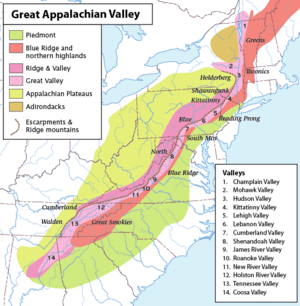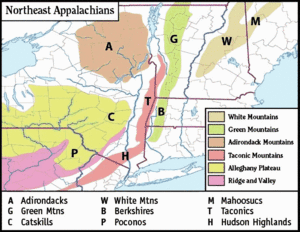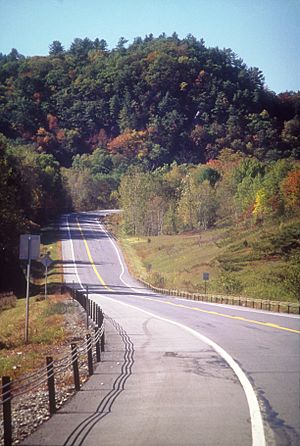Washington County, New York facts for kids
Quick facts for kids
Washington County
|
|||
|---|---|---|---|
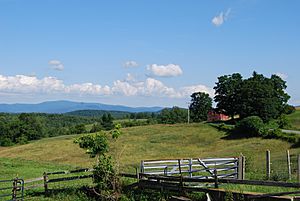
A farm in Greenwich
|
|||
|
|||
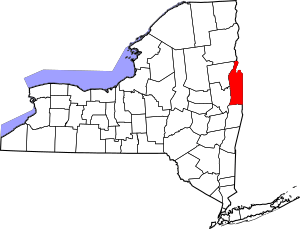
Location within the U.S. state of New York
|
|||
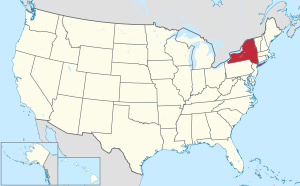 New York's location within the U.S. |
|||
| Country | |||
| State | |||
| Founded | March 12, 1772 (Took its name on April 2, 1784) | ||
| Named for | George Washington | ||
| Seat | Fort Edward | ||
| Largest village | Hudson Falls | ||
| Area | |||
| • Total | 846 sq mi (2,190 km2) | ||
| • Land | 831 sq mi (2,150 km2) | ||
| • Water | 15 sq mi (40 km2) 1.7% | ||
| Population
(2020)
|
|||
| • Total | 61,302 | ||
| • Estimate
(2023)
|
60,047 |
||
| • Density | 72.46/sq mi (27.977/km2) | ||
| Time zone | UTC−5 (Eastern) | ||
| • Summer (DST) | UTC−4 (EDT) | ||
| Congressional district | 21st | ||
Washington County is a special area called a 'county' in New York State. In 2020, about 61,302 people lived here. The main town where the county government is located is Fort Edward. This county got its name from George Washington, who was a famous general and later a President of the United States. It's part of a bigger area in New York called the Capital District.
Contents
Discovering Washington County's Past
When New York was still a colony in 1683, the area that is now Washington County was part of a huge place called Albany County. This county was so big it included parts of what is now Vermont!
Over time, Albany County got smaller. In 1772, it was split into three parts. One of these new parts was called Charlotte County.
Then, on April 2, 1784, Charlotte County was renamed Washington County. This was done to honor George Washington, who was a hero of the American Revolutionary War and later became the first President of the United States.
Through the years, Washington County also changed its shape.
- In 1788, Clinton County was created from a part of Washington County.
- In 1791, the Town of Cambridge joined Washington County from Albany County.
- In 1813, Warren County was formed from another part of Washington County.
The county seat, which is like the main office for the county government, moved in 1994. It moved from Hudson Falls to Fort Edward.
In 2006, Jo Ann Trinkle made history. She was elected as the first chairwoman of the Board of Supervisors for the county.
Historic Bridges and Landmarks
Washington County is home to four old covered bridges. These bridges are special because they are listed on the National Register of Historic Places. This means they are important historical sites!
- Buskirk Bridge
- Eagleville Bridge
- Rexleigh Bridge
- Shushan Bridge
Overall, there are 35 places in Washington County listed on the National Register of Historic Places. The Lemuel Haynes House is even more special. It's a National Historic Landmark, which is the highest level of historical importance.
Exploring Washington County's Geography
Washington County covers about 846 square miles. Most of this area, about 831 square miles, is land. The rest, about 15 square miles, is water.
This county is long and narrow, located in the northeastern part of New York State. It's famous for its rich farmland in the valleys. It's also part of the Great Appalachian Valley, which is a long, narrow valley often found between tall mountain ranges.
The county sits where the Taconic Mountains meet the Adirondack Mountains. It also connects the Lake Champlain Valley to the Hudson River Valley.
The eastern edge of Washington County is the border between New York and Vermont. Part of this border is Lake Champlain. The northern part of the county is inside the huge Adirondack Park. The western borders are mostly the Hudson River and Lake George.
Rivers and Mountains
Water in the northern part of the county flows into Lake Champlain and then into the Saint Lawrence River. These waters eventually reach the Atlantic Ocean. Water in the southern part flows into the Hudson River, which also leads to the Atlantic Ocean near New York City.
The famous Batten Kill river winds through the southern part of the county. It's known worldwide for fly fishing and its beautiful waterfalls.
Black Mountain, located in the Adirondacks, is the tallest point in Washington County. It's about 2,640 feet high. From its top, you can see amazing views of Lake George, Lake Champlain, and the surrounding mountains. Willard Mountain is a ski center in the southern part of the county, perfect for winter fun!
Neighboring Counties
Washington County shares its borders with these other counties:
- Essex County – to the north
- Addison County, Vermont – to the northeast
- Rutland County, Vermont – to the east
- Bennington County, Vermont – to the southeast
- Rensselaer County – to the south
- Saratoga County – to the southwest
- Warren County – to the west
People of Washington County
| Historical population | |||
|---|---|---|---|
| Census | Pop. | %± | |
| 1790 | 14,077 | — | |
| 1800 | 35,574 | 152.7% | |
| 1810 | 44,289 | 24.5% | |
| 1820 | 38,831 | −12.3% | |
| 1830 | 42,635 | 9.8% | |
| 1840 | 41,080 | −3.6% | |
| 1850 | 44,750 | 8.9% | |
| 1860 | 45,904 | 2.6% | |
| 1870 | 49,568 | 8.0% | |
| 1880 | 47,871 | −3.4% | |
| 1890 | 45,690 | −4.6% | |
| 1900 | 45,624 | −0.1% | |
| 1910 | 47,778 | 4.7% | |
| 1920 | 44,888 | −6.0% | |
| 1930 | 46,482 | 3.6% | |
| 1940 | 46,726 | 0.5% | |
| 1950 | 47,144 | 0.9% | |
| 1960 | 48,476 | 2.8% | |
| 1970 | 52,725 | 8.8% | |
| 1980 | 54,795 | 3.9% | |
| 1990 | 59,330 | 8.3% | |
| 2000 | 61,042 | 2.9% | |
| 2010 | 63,216 | 3.6% | |
| 2020 | 61,302 | −3.0% | |
| 2023 (est.) | 60,047 | −5.0% | |
| U.S. Decennial Census 1790-1960 1900-1990 1990-2000 2010-2020 |
|||
In 2000, there were 61,042 people living in Washington County. About 33.2% of households had children under 18. The average household had 2.55 people.
The population was spread out by age:
- 24.6% were under 18 years old.
- 8.3% were from 18 to 24 years old.
- 29.4% were from 25 to 44 years old.
- 23.7% were from 45 to 64 years old.
- 14.0% were 65 years or older.
The average age in the county was 38 years. For every 100 females, there were about 105 males.
2020 Census Information
| Race | Num. | Perc. |
|---|---|---|
| White (NH) | 54,605 | 89.1% |
| Black or African American (NH) | 1,563 | 2.6% |
| Native American (NH) | 149 | 0.24% |
| Asian (NH) | 319 | 0.52% |
| Pacific Islander (NH) | 22 | .03% |
| Other/Mixed (NH) | 2,883 | 4.7% |
| Hispanic or Latino | 1,761 | 2.9% |
Getting Around Washington County
Airports
There are a few small airports in the county for public use:
Train Services
Amtrak offers train services through Washington County. The Adirondack and Ethan Allen Express trains travel here daily. These trains connect New York City to places like Montreal, Québec or Burlington, Vermont.
Both trains stop in Fort Edward. The Adirondack train also stops in Whitehall.
Communities in Washington County
Washington County is made up of different types of communities.
Towns
Villages
Census-Designated Places (CDPs)
These are areas identified by the Census Bureau for statistical purposes.
- North Granville
- Salem
Hamlets
Hamlets are small communities, often without their own local government.
Famous People from Washington County
Many interesting people have connections to Washington County:
- Frank Buckley Walker: A talent agent who helped discover famous musicians like Bessie Smith and Hank Williams.
- Townsend Harris: The very first United States Consul-General to Japan.
- Chester A. Arthur: He lived in Greenwich for five years when he was young. He later became the 21st President of the United States in 1881.
- Grandma Moses: A well-known American painter.
- Josh Carter: A musician in the American music duo, Phantogram.
- Susan B. Anthony: A very important leader in the 19th-century women's rights movement. She worked hard to help women gain the right to vote in the United States. She moved to Battenville, New York, when she was six years old.
- Solomon Northup: He was born a free African American and had a farm in Hebron. Sadly, he was kidnapped in 1841 and forced into slavery. After being freed in 1853, he wrote a famous book about his experiences called Twelve Years a Slave. This book has been made into movies.
- Sigurd Raschèr: A famous saxophonist who helped develop music for the concert saxophone in the 20th century. He lived in Shushan, New York.
- James Howard Kunstler: An author known for books like The Geography of Nowhere and The Long Emergency.
- John L. Beveridge: He was the 16th Governor of Illinois and also served in the U.S. House of Representatives. He was born in the town of Greenwich in 1824.
- James M. Hinds: Born and raised in Hebron, he served in the U.S. House of Representatives. He was sadly assassinated in 1868 because he supported civil rights for former slaves.
See also
 In Spanish: Condado de Washington (Nueva York) para niños
In Spanish: Condado de Washington (Nueva York) para niños




